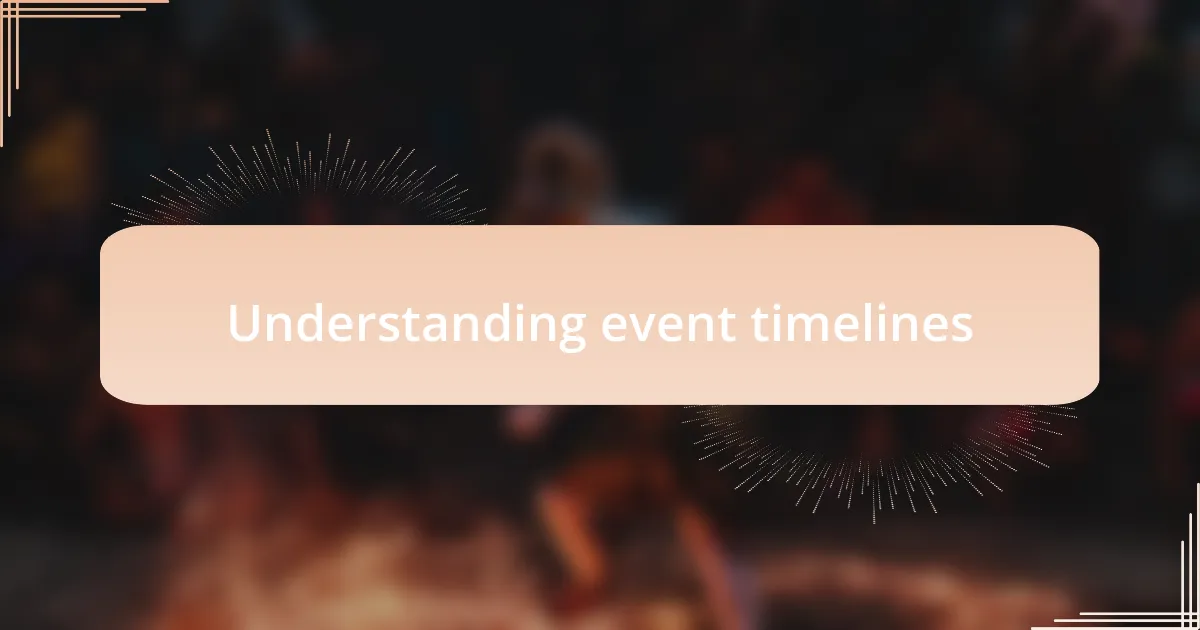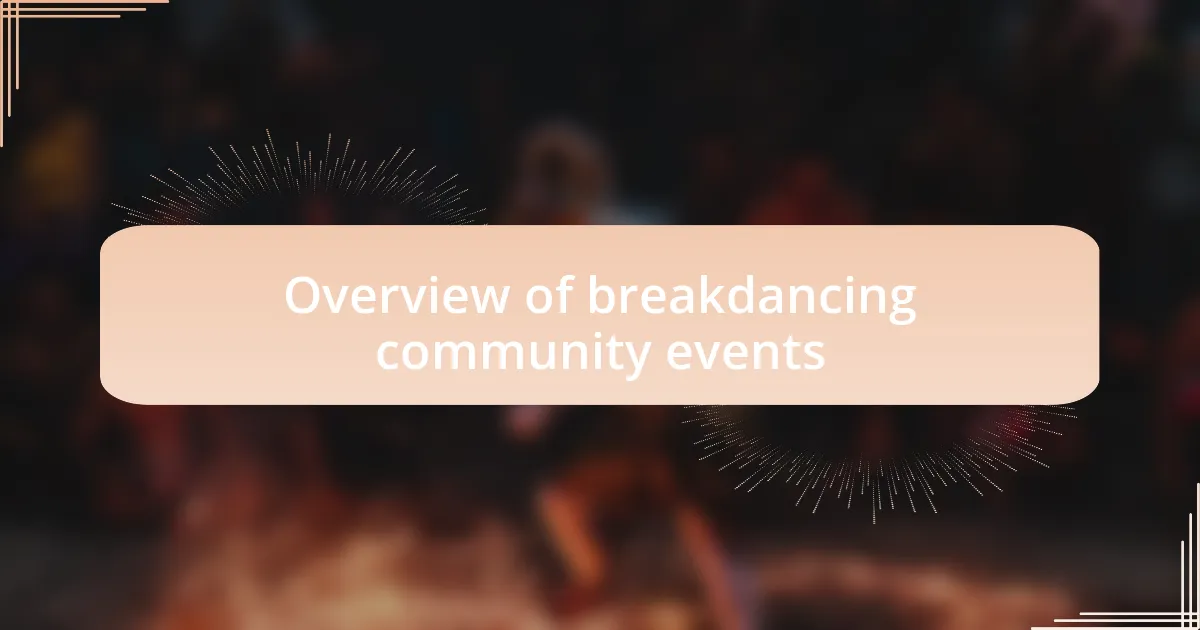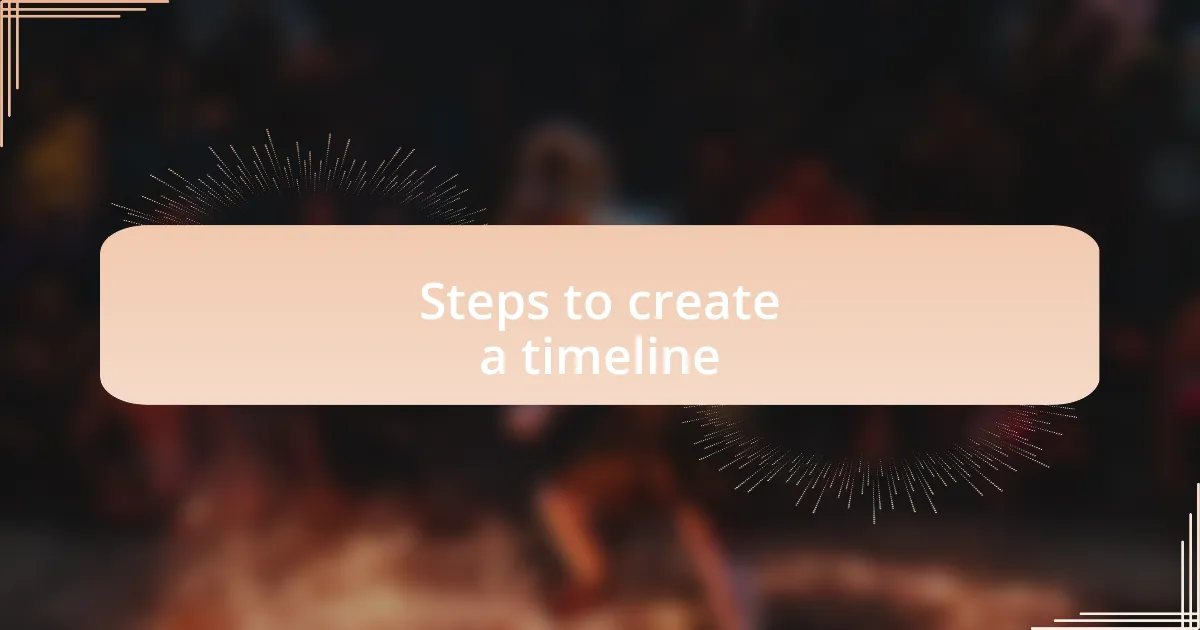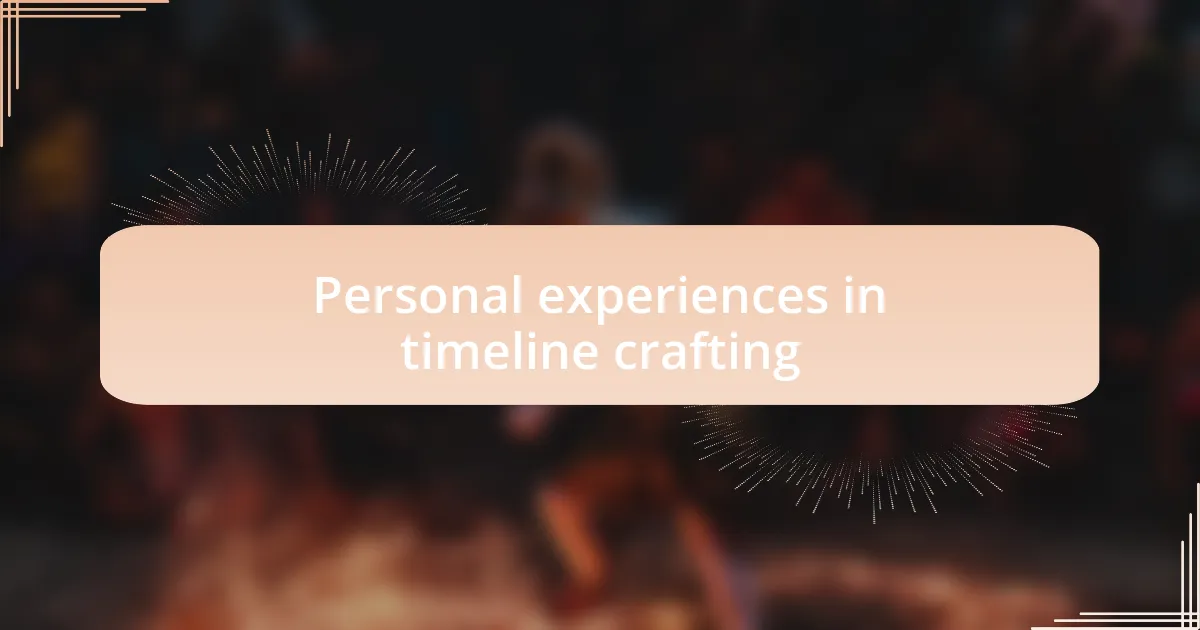Key takeaways:
- Effective event timelines enhance organization, audience engagement, and overall experience, creating memorable moments during performances.
- Incorporating essential breakdancing elements like cyphers, live DJ sets, and judge feedback fosters authenticity and community connection.
- Flexibility in timeline management allows for spontaneity and adaption to audience feedback, enhancing emotional resonance throughout the event.

Understanding event timelines
Event timelines serve as the backbone of any successful gathering, ensuring that everything flows smoothly and stays on track. I remember planning a breakdancing showcase where every minute counted. That experience taught me how crucial it is to allocate time wisely for each dance battle and performance, creating a rhythm not just for the dancers but for the audience too.
Each element in an event timeline plays a vital role, from the arrival of the dancers to the climactic final showdown. Have you ever attended a competition where you could feel the excitement building as the clock ticked down? That tension is crafted through careful planning and pacing, which ultimately shapes the entire experience. When I witnessed dancers feeding off the crowd’s energy, I realized that a well-structured timeline elevates the event’s atmosphere.
Understanding how to craft these timelines involves recognizing the emotional beats of the event. Picture a moment where the crowd erupts in cheer after a phenomenal performance; that doesn’t just happen by chance. I learned that by setting intentional breaks for audience engagement and excitement, you create memorable highlights that resonate long after the event is over. Isn’t that the ultimate goal in event planning?

Importance of timelines in events
Timelines are essential for setting expectations, both for organizers and attendees. I recall a breakdancing event where we mismanaged our timeline, resulting in two dance crews arriving too late for their battles. The frustration in the air was palpable, reminding me how deficits in timing can overshadow even the most talented performances. A well-defined timeline ensures everyone understands their roles and when they will shine.
Having a clear timeline enhances the audience’s experience by building anticipation. I remember feeling goosebumps as the announcer called out performers against the ticking clock, an exhilarating countdown that heightened the crowd’s energy. When events seamlessly unfold, it allows the audience to become fully immersed, drawing them deeper into the art of breakdancing and creating unforgettable memories.
Moreover, a timeline fosters communication among the team, ensuring everyone is on the same page. In a previous competition, we had a detailed flowchart that outlined not only the event’s start and end times but also transition moments for setting up different stages. This clarity kept our volunteers motivated and engaged, as they could visibly see the unfolding of the event. How often do we take the time to appreciate the collective effort that a solid timeline brings to life?

Overview of breakdancing community events
The breakdancing community is vibrant and diverse, often coming together for events that celebrate this incredible art form. From local jam sessions to competitive battles, each event fosters a sense of connection among dancers and spectators. I remember a neighborhood block party where we were able to transform a simple street into a lively dance floor, and the sense of unity among participants was truly inspiring.
At larger competitions, the stakes are often high, drawing in talent from various backgrounds. I once attended a regional qualifier where the atmosphere was electric; you could feel everyone’s anticipation. It’s amazing to see how these competitions not only showcase skills but also encourage camaraderie among dancers, who inspire each other even when they’re competing.
Workshops and showcases are also integral to the community, offering opportunities for skill development and cultural exchange. I recall a workshop led by a legendary b-boy, where the room was alive with energy and eagerness to learn. These moments are crucial as they foster growth and passion, reminding us all of why we love breakdancing in the first place. What better way to strengthen our community than by learning from one another and sharing our experiences?

Steps to create a timeline
When creating a timeline for an event, I find it essential to first outline the key milestones. Consider the sequence of events that will unfold throughout the day, from the opening circles to the final battles. Just the other week, I was involved in planning a local competition, and we mapped out everything from registration times to the after-party, ensuring each moment was accounted for. How can you create excitement if people don’t know when to show up?
Next, I believe it’s important to allocate specific time slots for each activity. This part requires a careful balance; too much time could lead to boredom, while too little might rush the experience. During a previous jam, we scheduled dance showcases, and I remember feeling a wave of excitement as the clock counted down to each performance—it’s those moments that create a dynamic atmosphere.
Lastly, I always recommend sharing the timeline with all participants and volunteers. Clarity is key, as I learned the hard way when I once hosted an event without clearly communicating the schedule. It turned into a scramble! Engaging everyone in this process not only ensures they’re informed but helps them feel like a part of the fabric of the event. It’s truly rewarding to see how everyone contributes to making the timeline a success.

Incorporating key breakdancing elements
Incorporating key breakdancing elements into the timeline requires a deep understanding of the culture and its rhythms. When I was involved in a b-boy battle last year, I remember how crucial it was to highlight cypher moments. These spontaneous circles of dancers fuel the excitement of the event; if you don’t carve out dedicated times for them, you risk missing that authentic energy that makes breakdancing so vibrant. Who would want to dance when they feel rushed?
Another important aspect is integrating live DJ sets, which often set the tone for performances and battles. I once attended an event where the DJ played a perfect mix of classic and current tracks, and the energy in the room shifted instantly. The connection between the DJ and the dancers is powerful; it can elevate a good jam to an unforgettable party. Why leave that crucial element to chance when you could plan it into the timeline?
Finally, don’t forget to include time for judge training and feedback sessions. I vividly recall a competition where the judges’ insights sparked a new level of motivation among the dancers. By dedicating time for judges to discuss criteria and offer constructive critiques, everyone leaves feeling empowered and inspired. Isn’t that what we want from these gatherings—to grow as dancers and as a community?

Personal experiences in timeline crafting
Crafting a timeline for an event involves a level of intuition that only comes from experience. I remember putting together a timeline for a local jam where I miscalculated the time for the battles. The pressure was palpable when we had to rush through the finals, and it disappointed many. Those moments taught me how essential it is to be flexible and attentive to the flow of the event.
One time, during an event I helped organize, I learned the importance of community feedback. After the competition, we gathered input from both dancers and spectators. Their feedback revealed how crucial it was to schedule moments for impromptu workshops. People crave those chances to learn from each other—why would you ever want to overlook such an opportunity for connection?
A significant takeaway from my journey in timeline crafting is the emotional pulse of the event. I once noticed how silence fell over the crowd when a dancer began to share their personal story before their performance. That recognition of shared experience added depth to the event. It reminds me that while we focus on logistics, we should never lose sight of the genuine emotions that can turn a timeline into a memorable experience.

Tips for memorable event timelines
When planning memorable event timelines, I find that integrating breaks between segments can work wonders. At one particular b-boy battle, I scheduled a short break right after the intense qualifying rounds. This brief pause allowed everyone to absorb the energy, share their thoughts, and even have quick dance-offs in the sidelines, enhancing overall engagement. Have you ever noticed how those little intermissions can elevate the vibe of an event?
Being mindful of the audience’s attention span is also fundamental. I vividly recall a showcase where I underestimated the time needed for audience engagement. It was during a Q&A session with an accomplished dancer that I recognized the value of spontaneity. The audience’s curiosity sparked a dynamic conversation, and the timeline’s flexibility allowed us to savor that moment. How often do we dismiss the unpredictable magic that feedback can bring?
Storytelling elements woven into the timeline can create lasting memories. Once, I introduced a segment dedicated to sharing personal journeys of seasoned dancers before their showcases. The way their stories resonated with the crowd enriched the overall atmosphere, turning a simple event into a shared experience. Have you considered how storytelling can enhance the emotional connections within your timelines?